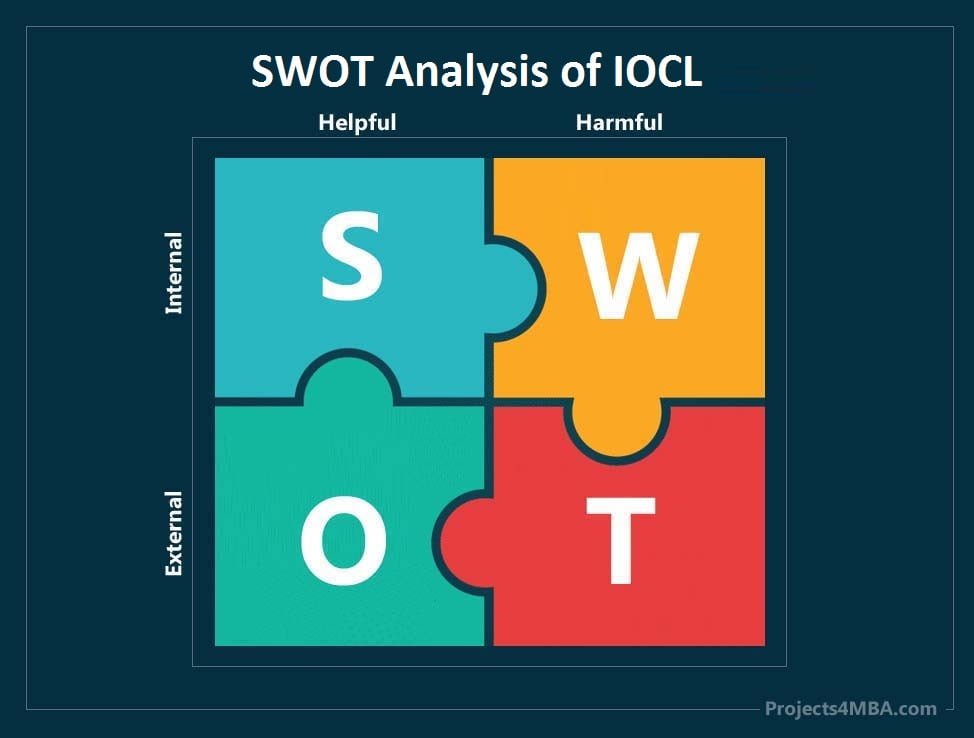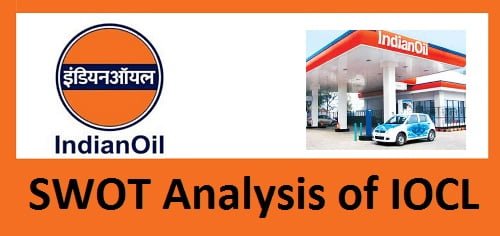SWOT Analysis of IOCL (Indian Oil Corporation Limited) focuses on Strengths, weaknesses, opportunities, and threats. Strength and Weakness are the internal factors and Opportunities and Threats are the external factors that influence the SWOT Analysis of IOCL (Indian Oil Corporation Limited).
Indian Oil Corporation Limited is another name for IOCL. It is a gas and oil corporation that is wholly controlled by the Ministry of Petroleum and Natural Gas, Government of India. It is India’s largest commercial oil corporation, and it was placed first on the Fortune India 500 list. It employs over 33,498 people and has vast distribution, marketing, and refining capabilities.

The organization has a network of 47,801 touchpoints that are constantly expanding. Indian Oil has played an important part in India’s socio-economic growth, regularly providing energy access to millions of people across the country. IOCL has generated revenue of 68 Billion US Dollars in 2020. The company has reported a Net Profit of 2.9961 billion US Dollars in the year 2020-21.

Strengths in the SWOT Analysis of IOCL – IOCL SWOT Analysis
- Strong Network: With a large distribution network of 10,000 distributors, IndianOil has a brand of LPG cooking gas called Indane that serves 12 crore households. With the brand Servo, it is a market leader in the lubrication industry. Every day, 1,750 planes are powered by the company’s 107 aviation fuel systems. IOCL is one of India’s top brands. The firm was named one of India’s “Most Trusted Brands” in the “Gasoline” category by Reader’s Digest-AC Nielsen Survey. The firm has lived true to the brand’s goal by pledging to cultivate customer relationships, innovate, harness technology, and care for the environment and the community.
- Pipeline Network: The corporation owns and operates 13,400 kilometers of cross-country pipelines that transport crude oil, processed petroleum products, and natural gas. The business just completed the installation of 543 kilometers of new pipeline sections. The company owns and administers two SPM terminals in Vadinnar’s high seas, as well as three more SPMSingle-Point Mooring (SPM) terminals in Paradip that are used to moor pipeline systems that transport crude oil from ocean tankers to onshore tank farms. The corporation operates crude oil tank farms with massive capacities, ensuring seamless onward transfer to refineries through pipelines.
- State of Art Research and Development Facility: IOCL has the most advanced R&D facility. It has conducted pioneering research in the fields of lubricants, pipelines, refineries, alternative fuels, engine testing, and environmental sciences. In India and other countries, the business holds 554 patents. The research and development facility is located on a vast 65-acre complex in Faridabad, India. The center has been successful in developing technological solutions that are cost-effective, socially responsible, and ecologically friendly. IOCL focuses on cutting-edge research in nanotechnology, polymers, coal gasification, and petrochemicals, and polymers and petrochemicals.
- Focus on Sustainability: The corporation has long believed in sustainability and was an early investor in renewable energy sources, amassing a 200-MW portfolio of solar and wind generating capacity that is quickly expanding. Under the government’s Swachh Bharat Abhiyan, IOCL is investing in and researching many waste-to-energy solutions. IOCL is also the industry leader in transforming the retail network to run on solar energy, with almost one-third of its gasoline stations using solar power. The majority of the company’s efforts are aimed at making its operations more environmentally friendly, with the goal of reducing its water and carbon footprints by 20% and 18%, respectively.
- Strong Brand Portfolio: Over the years, IOCL has made significant investments in developing a strong brand portfolio. This is reinforced by IOCL’s SWOT analysis. If the company wishes to grow into other product categories, this brand portfolio may be quite beneficial.
- Effective Go To Market Strategy: Its Go To Market techniques for its products have been extremely effective.
- Good Training Programmes: Successful training and learning programmes have resulted in a highly competent workforce. IOCL invests heavily in employee training and development, resulting in a team that is not just highly competent but also driven to achieve more.
Weakness in the SWOT Analysis of IOCL – IOCL SWOT Analysis
- Tough Competition: Reliance Industries, ONGC, Hindustan Petroleum, and Bharat Petroleum are IOCL’s key competitors. Bharat Petroleum, another major rival of IOCL, has invested in different R&D initiatives. It also operates huge refineries in Mumbai and Cochin and is a Fortune 500 company. To keep ahead of the competition and avoid losing market share, IOCL must make strategic decisions and investments.
- Government Control: IOCL has suffered significant losses as a result of the government’s management of gasoline pricing policy because the center frequently fails to follow its commitments to keep gasoline costs artificially low. The corporation continues to borrow more and spend more in order to assure constant fuel supply to consumers, but growing interest costs slash their profit, limiting their capacity to drive the new project to modernize.
- Need more investment in new technologies: Given the scale of expansion and different geographies the company is planning to expand into, IOCL needs to put more money in technology to integrate the processes across the board. Right now the investment in technologies is not at par with the vision of the company.
Opportunities in the SWOT Analysis of IOCL – IOCL SWOT Analysis
- Growing Business and Demand: IOCL’s primary business has been transportation and distribution of petroleum products, as well as refining and other related activities, in response to India’s expanding need for fuel. Over the years, the firm has extended its activities throughout the hydrocarbon value chain, including oil and gas exploration, as well as diversification into natural and alternative energy sources.
- Market Expansion: IOCL has been steadily extending its business worldwide, with offices in the UAE, Bangladesh, Myanmar, Mauritius, Singapore, and the United States. The company has also expanded its operations through collaborative partnerships with reputable partners from both outside and India. Ratnagiri Refinery and Petrochemicals Ltd. was formed as a joint venture between BPCL and HPCL. The company is performing incredibly well in the international market and has been able to create several chances for the organization.
- Increasing natural gas market: Natural gas is developing as a cleaner alternative to fossil fuels, and the government of India is pushing for a gas-based economy and measures to utilize it across industries. IOCL obtains liquefied natural gas (LNG) from overseas suppliers with whom it has a long-term contract. Currently, IOCL distributes LNG to 58 institutional clients in the electricity, fertilizer, steel, and industrial sectors.
Threats in the SWOT Analysis of IOCL – IOCL SWOT Analysis
- Government Policies and Regulations: The government’s decision to provide citizens with relief from rising gasoline costs resulted in massive losses for the corporation. Companies such as IOCL, BPCL (Bharat Petroleum Corp. Ltd), and HPCL (Hindustan Petroleum Corp. Ltd) were predicted to lose Rs. 9000 crore in net profit. Certain government actions to reduce fuel and diesel prices have a significant impact on the company’s earnings.
- Economic Conditions: The corporation is dealing with a number of issues relating to rising oil costs, currency fluctuations, and growing worries about air pollution. The company’s goal and primary strategy are to address the difficulties and possibilities given by environmental circumstances, as well as to integrate and diversify activities across its worldwide business. In such uncertain conditions, the company’s effort to reduce costs across the supply chain is a monumental challenge.
- Liability Laws: Liability laws in different countries are different and XYZ may be exposed to various liability claims given change in policies in those markets.
- Currency Fluctuations: As the company is operating in numerous countries it is exposed to currency fluctuations especially given the volatile political climate in a number of markets across the world.
If you like this article you can recommend your friends about PROJECTS4MBA.COM
If you like This Article Please Like our Facebook Page PROJECTS4MBA
Cite This Work
Referencing Style to cite this article:
[citationic]